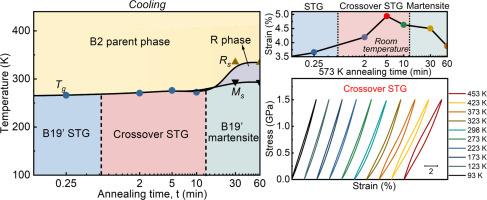当前位置:
X-MOL 学术
›
Acta Mater.
›
论文详情
Our official English website, www.x-mol.net, welcomes your
feedback! (Note: you will need to create a separate account there.)
Crossover strain glass alloy exhibiting large recoverable strain over a wide temperature range
Acta Materialia ( IF 8.3 ) Pub Date : 2024-11-04 , DOI: 10.1016/j.actamat.2024.120533 Yu Qian, Wenjia Wang, Yu Wang, Andong Xiao, Yao Liu, Ge Zhang, Zhizhi Xu, Yun Pan, Guanqi Wang, Xiaobing Ren, Yuanchao Ji
Acta Materialia ( IF 8.3 ) Pub Date : 2024-11-04 , DOI: 10.1016/j.actamat.2024.120533 Yu Qian, Wenjia Wang, Yu Wang, Andong Xiao, Yao Liu, Ge Zhang, Zhizhi Xu, Yun Pan, Guanqi Wang, Xiaobing Ren, Yuanchao Ji

|
Superelastic alloys, being successfully used in cutting-edge space technologies, are desired to possess large recoverable strain and wide working temperature range simultaneously. However, achieving such a combination has proven challenging. Here we report a finding of crossover strain glass transition in the crossover region between martensite and strain glass regimes of temperature vs. annealing-time phase diagram of cold-rolled Ti50 Ni50 alloys. The crossover strain glass alloy exhibits a large recoverable strain of ∼ 4%-6% and ultrawide working temperature range from 453 to 93 K, outperforming previously reported superelastic alloys. Moreover, such exceptional properties were revealed to stem from the crossover strain glass transition occurring at a high transition temperature T g ∼ 276 K, which possesses a unique transition behavior of strain glass transition accompanied by a sluggish and partial martensitic transformation from strain glass to martensite with cooling. This transition was further characterized by in-situ microscopic observations: upon cooling both several nanometer-sized and dozens of nanometer-sized B19’ martensitic domains gradually appear and increase in the matrix of B2 parent phase over a wide temperature range, which contribute to large recoverable strain and ultrawide working temperature range. Our work indicates that the crossover strain glass may provide a new mechanism to achieve large recoverable strain over a wide temperature range, and large field-induced strain over a wide temperature range may be obtained in other crossover ferroic glasses.
中文翻译:

交叉应变玻璃合金在较宽的温度范围内表现出较大的可恢复应变
超弹性合金已成功应用于尖端航天技术,需要同时具有较大的可恢复应变和较宽的工作温度范围。然而,事实证明,实现这样的组合具有挑战性。在这里,我们报告了冷轧 Ti50Ni50 合金的温度与退火时间相图在马氏体和应变玻璃状态之间的交叉区域中交叉应变玻璃化转变的发现。交叉应变玻璃合金表现出 ∼ 4%-6% 的大可恢复应变和 453 至 93 K 的超宽工作温度范围,优于以前报道的超弹性合金。此外,这种特殊的性能源于在高转变温度 Tg ∼ 276 K 下发生的交叉应变玻璃转变,它具有独特的应变玻璃转变行为,伴随着冷却从应变玻璃到马氏体的缓慢和部分马氏体转变。原位显微镜观察进一步表征了这种转变:冷却后,在较宽的温度范围内,B2母相的基体中逐渐出现和增加几个纳米级和数十个纳米级的 B19' 马氏体畴,这有助于较大的可恢复应变和超宽的工作温度范围。我们的工作表明,交叉应变玻璃可能提供了一种在较宽温度范围内实现大可恢复应变的新机制,而在其他交叉铁质玻璃中可能获得较宽温度范围内的大场诱导应变。
更新日期:2024-11-04
中文翻译:

交叉应变玻璃合金在较宽的温度范围内表现出较大的可恢复应变
超弹性合金已成功应用于尖端航天技术,需要同时具有较大的可恢复应变和较宽的工作温度范围。然而,事实证明,实现这样的组合具有挑战性。在这里,我们报告了冷轧 Ti50Ni50 合金的温度与退火时间相图在马氏体和应变玻璃状态之间的交叉区域中交叉应变玻璃化转变的发现。交叉应变玻璃合金表现出 ∼ 4%-6% 的大可恢复应变和 453 至 93 K 的超宽工作温度范围,优于以前报道的超弹性合金。此外,这种特殊的性能源于在高转变温度 Tg ∼ 276 K 下发生的交叉应变玻璃转变,它具有独特的应变玻璃转变行为,伴随着冷却从应变玻璃到马氏体的缓慢和部分马氏体转变。原位显微镜观察进一步表征了这种转变:冷却后,在较宽的温度范围内,B2母相的基体中逐渐出现和增加几个纳米级和数十个纳米级的 B19' 马氏体畴,这有助于较大的可恢复应变和超宽的工作温度范围。我们的工作表明,交叉应变玻璃可能提供了一种在较宽温度范围内实现大可恢复应变的新机制,而在其他交叉铁质玻璃中可能获得较宽温度范围内的大场诱导应变。


















































 京公网安备 11010802027423号
京公网安备 11010802027423号